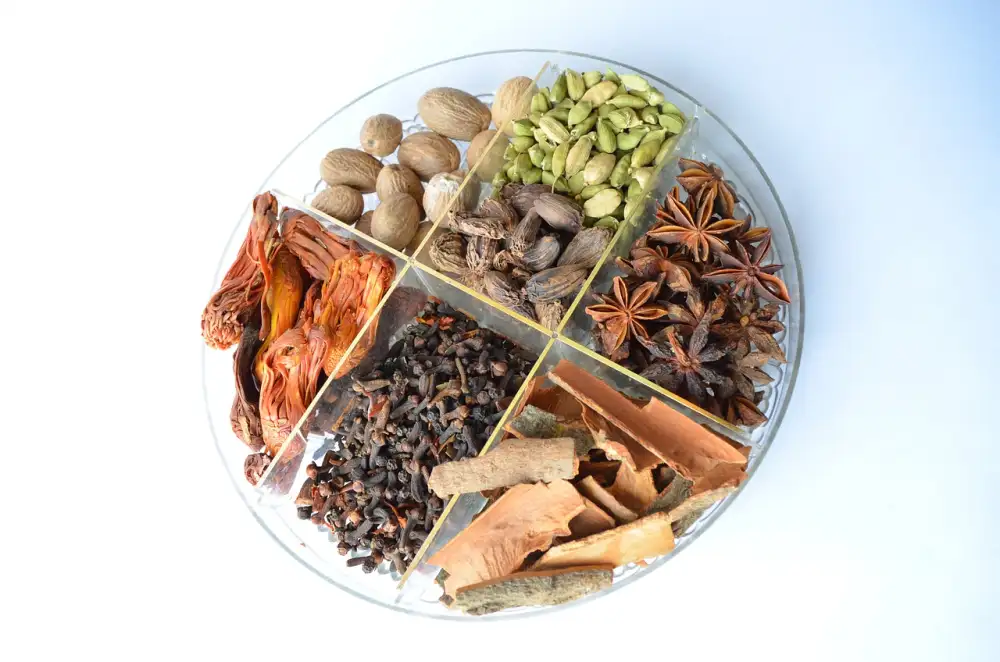Discover the Vibrant World of Indian Spices: Essential Ingredients for Authentic Indian Recipes

Indian cuisine is renowned for its rich flavors and aromatic dishes, and at the heart of this vibrant culinary tradition are the diverse and exotic spices. Indian spices not only add depth and complexity to dishes but also offer a myriad of health benefits. From enhancing digestion to boosting immunity, these spices have been treasured for centuries for their medicinal properties.
The use of spices in Indian cooking dates back thousands of years, with each region boasting its own unique blend of flavors. These spices are not just used for heat or spiciness; they are carefully selected to create a harmonious balance of taste, aroma, and color in every dish.
Whether you're a seasoned chef or an adventurous home cook, exploring the world of Indian spices will open up a whole new realm of culinary possibilities. So let's dive into the enchanting world of Indian spices and discover the essential ingredients that make authentic Indian recipes truly extraordinary.
Commonly Used Indian Spices
Indian cuisine is known for its rich and diverse flavors, which are achieved through the use of a wide variety of spices. These spices not only add depth and complexity to dishes but also offer numerous health benefits. Let's explore some commonly used Indian spices that are essential for authentic Indian recipes.
- Turmeric: Known for its vibrant yellow color, turmeric is widely used in Indian cooking. It has a warm and earthy flavor and is often used in curries, rice dishes, and marinades. Turmeric is also renowned for its anti-inflammatory properties.
- Cumin: Cumin seeds have a distinct nutty and peppery flavor. They are commonly used as a seasoning in Indian dishes such as dal (lentil soup), biryani, and vegetable curries. Cumin is believed to aid digestion and improve immunity.
- Coriander: Both the seeds and leaves of coriander are used in Indian cuisine. The seeds have a citrusy flavor while the leaves add freshness to dishes. Coriander is an essential ingredient in curry powders, chutneys, and marinades.
- Cardamom: This aromatic spice has a sweet and floral flavor with hints of citrus. It is often used in desserts like kheer (rice pudding) and beverages like masala chai (spiced tea). Cardamom also aids digestion and freshens breath.
- Cloves: Cloves have a strong and pungent flavor with hints of sweetness. They are commonly used in rice dishes, meat curries, and spice blends like garam masala. Cloves possess antimicrobial properties and can help relieve toothaches.
- Cinnamon: With its warm and sweet taste, cinnamon adds warmth to both sweet and savory dishes. It is used in biryanis, stews, desserts like gulab jamun (sweet dumplings), and beverages like spiced cider. Cinnamon is also known for its anti-inflammatory and antioxidant properties.
- Mustard Seeds: These tiny seeds have a nutty and spicy flavor. They are often used in tempering (a cooking technique) to add a burst of flavor to dishes like curries, pickles, and chutneys. Mustard seeds are believed to boost metabolism and aid digestion.
- Fenugreek: Fenugreek leaves and seeds have a slightly bitter taste with hints of maple syrup. They are commonly used in curries, lentil dishes, and spice blends. Fenugreek is known for its potential to lower blood sugar levels and improve digestion.
- Ginger: Ginger has a warm and spicy flavor that adds zing to Indian dishes. It is used in curries, stir-fries, beverages like ginger tea, and desserts like gingerbread. Ginger is well-known for its anti-inflammatory properties and ability to soothe digestive issues.
- Garlic: Garlic has a pungent and savory flavor that enhances the taste of various dishes. It is used in curries, marinades, chutneys, and bread spreads like garlic naan. Garlic offers numerous health benefits including boosting the immune system.
These commonly used Indian spices form the foundation of many traditional recipes, adding depth, aroma, and distinct flavors to Indian cuisine. By incorporating these spices into your cooking repertoire, you can elevate your dishes to new heights of deliciousness while reaping their health benefits as well.
1. Turmeric
Turmeric is a vibrant yellow spice commonly used in Indian cuisine. It has a warm, earthy flavor with a slightly bitter undertone. Not only does turmeric add color to dishes, but it also offers numerous health benefits. It is known for its anti-inflammatory properties and is often used as a natural remedy for various ailments. Turmeric can be used in both sweet and savory dishes, including curries, rice dishes, soups, and even desserts. Its distinct flavor and vibrant hue make it an essential ingredient in authentic Indian recipes.
2. Cumin
Cumin is one of the most widely used spices in Indian cuisine, known for its warm and earthy flavor. It adds a distinct aroma and depth to dishes, making it an essential ingredient in many authentic Indian recipes. Cumin seeds are small and oblong with a slightly bitter taste. They can be used whole or ground, depending on the recipe. When toasted or roasted, cumin releases its full flavor and fragrance. It pairs well with other spices like coriander and turmeric, creating a flavorful base for curries, stews, and rice dishes. Whether you're making a classic curry or experimenting with fusion flavors, cumin is a must-have spice that will elevate your dishes to new heights.
3. Coriander
Coriander is a versatile spice that is widely used in Indian cuisine. It has a warm, citrusy flavor with hints of sweetness and earthiness. The seeds are commonly used whole or ground into a powder. Coriander powder adds depth and aroma to curries, stews, and marinades. It pairs well with other spices like cumin and turmeric, enhancing the overall flavor profile of the dish. Additionally, fresh coriander leaves, also known as cilantro, are used as a garnish or added towards the end of cooking for a burst of freshness. Whether you're making a spicy curry or a refreshing chutney, coriander is an essential ingredient that brings vibrancy to your Indian recipes.
4. Cardamom
Cardamom is a highly aromatic spice that is widely used in Indian cuisine. It has a unique flavor profile that is both sweet and spicy, with hints of citrus and mint. There are two main types of cardamom: green and black. Green cardamom is the most commonly used variety and is often added to desserts, tea, and savory dishes. It adds a refreshing and uplifting note to any recipe. Black cardamom has a smoky flavor and is typically used in meat dishes and curries. Both varieties can be used whole or ground, depending on the recipe. Cardamom not only enhances the taste of dishes but also provides several health benefits, including improving digestion and promoting oral health. So, don't hesitate to include this versatile spice in your pantry to add an exotic touch to your cooking!
5. Cloves
Cloves are a popular spice in Indian cuisine, known for their strong and distinct flavor. These small, dried flower buds add a warm and sweet taste to dishes. Cloves are often used in both sweet and savory recipes, providing a unique aroma and depth of flavor. They are commonly used in curries, rice dishes, soups, and desserts. In addition to their culinary uses, cloves also have medicinal properties and are believed to aid digestion and relieve toothaches. Adding cloves to your dishes will surely elevate the flavors and transport you to the vibrant world of Indian spices.
6. Cinnamon
Cinnamon is a popular spice in Indian cuisine, known for its warm and sweet flavor. It is derived from the bark of the cinnamon tree and adds a distinct aroma to dishes. In Indian cooking, cinnamon is used in both savory and sweet recipes. It pairs well with meats, vegetables, rice, and desserts. Its versatility makes it a must-have spice in any Indian kitchen. Whether you're making biryani or kheer, adding a pinch of cinnamon can elevate the flavors of your dish to new heights. So don't forget to include this fragrant spice in your pantry for an authentic Indian culinary experience.
7. Mustard Seeds
Mustard seeds are a staple in Indian cuisine and add a unique flavor and texture to dishes. They come in three varieties: black, brown, and yellow. The black mustard seeds have a strong, pungent taste, while the brown ones are milder. Yellow mustard seeds are commonly used for pickling and making mustard sauce. These tiny seeds are often tempered in hot oil before adding them to curries, stir-fries, or chutneys. They release a nutty aroma and provide a subtle heat that enhances the overall flavor of the dish. Mustard seeds are also rich in antioxidants and have various health benefits, including aiding digestion and reducing inflammation.
8. Fenugreek
Fenugreek is an essential spice in Indian cuisine, known for its unique flavor and aroma. These small, golden-brown seeds have a slightly bitter taste with hints of maple syrup. Fenugreek is commonly used in both whole and powdered form in various dishes.
The seeds are often toasted or roasted before being ground into a powder to enhance their flavor. They add depth and complexity to curries, stews, and lentil dishes. Fenugreek is also a key ingredient in many spice blends like garam masala.
Apart from its culinary uses, fenugreek has several health benefits. It is believed to aid digestion, reduce inflammation, and regulate blood sugar levels. Fenugreek leaves, known as methi, are also used as a herb in cooking and are rich in vitamins and minerals.
To use fenugreek in your recipes, you can either temper the whole seeds in hot oil or dry roast them before grinding. The powdered form can be added directly to your dishes during cooking. However, it's important to use fenugreek sparingly as its strong flavor can easily overpower other ingredients.
In conclusion, fenugreek is a versatile spice that adds a distinct taste to Indian dishes. Its unique flavor profile and numerous health benefits make it a must-have ingredient for anyone looking to explore the vibrant world of Indian spices. So go ahead and experiment with fenugreek to elevate the flavors of your favorite recipes!
9. Ginger
Ginger, known for its unique flavor and aroma, is a staple in Indian cuisine. It adds a warm, spicy kick to dishes and is used in both sweet and savory recipes. Whether fresh or dried, ginger brings a zesty and refreshing element to curries, stir-fries, and marinades. Its medicinal properties are also well-known, aiding digestion and providing relief from nausea. Embrace the versatility of ginger and elevate your Indian dishes with its vibrant taste.
10. Garlic
Garlic is an essential ingredient in Indian cuisine, known for its strong and pungent flavor. It adds a distinct taste and aroma to dishes, making them more flavorful and delicious. Garlic is used in various forms in Indian cooking, including fresh cloves, minced garlic, or garlic paste. It is often sautéed with onions as a base for curries or added to marinades for meat and vegetables. Apart from its culinary uses, garlic is also known for its health benefits, such as boosting the immune system and reducing cholesterol levels. Incorporating garlic into your Indian recipes will not only enhance the taste but also provide numerous health benefits.
11. Chili Powder
Chili powder is a key ingredient in Indian cuisine, known for its fiery and bold flavor. It adds a kick to any dish and is used in both vegetarian and non-vegetarian recipes. Made from dried red chilies, chili powder not only adds heat but also imparts a deep red color to dishes.
In Indian cooking, chili powder is used in various forms such as whole dried chilies, ground powder, or even as a paste. It is often combined with other spices to create flavorful spice blends like garam masala or curry powder.
When using chili powder, it's important to adjust the quantity according to your taste preferences. If you prefer milder flavors, use less chili powder or remove the seeds before adding them to your dish. On the other hand, if you enjoy spicier food, feel free to add more chili powder for an extra kick.
Whether you're making curries, marinades, or even snacks like pakoras or samosas, chili powder is a must-have spice in your pantry. Its vibrant flavor will elevate your dishes and give them an authentic Indian touch.
So go ahead and experiment with chili powder in your cooking. Just remember to start with small amounts and gradually increase until you achieve the desired level of spiciness. Get ready to tantalize your taste buds with the bold flavors of Indian cuisine!
12. Garam Masala
Garam masala is a quintessential spice blend in Indian cuisine. It adds warmth and depth to dishes, making it a must-have ingredient for authentic Indian recipes. This aromatic blend typically consists of a combination of ground spices such as cinnamon, cloves, cardamom, cumin, coriander, and black pepper. The exact proportions may vary depending on the region or personal preferences. Garam masala is often added towards the end of cooking to preserve its flavors. Its rich and complex taste elevates curries, stews, and even rice dishes. Experiment with garam masala to unlock a whole new world of flavors in your cooking.
13. Asafoetida
Asafoetida is a unique spice commonly used in Indian cooking. It is derived from the resin of the Ferula plant and has a pungent aroma and flavor. In Indian cuisine, it is often used as a substitute for onion and garlic, making it perfect for those who prefer not to use these ingredients. Asafoetida adds a distinct umami taste to dishes and is especially popular in lentil curries and vegetable stir-fries. Just a pinch of this potent spice can elevate the flavors of your dishes and give them an authentic Indian touch.
14. Curry Leaves
Curry leaves are an essential ingredient in Indian cuisine, known for their distinct aroma and flavor. These small, shiny leaves are commonly used in South Indian dishes to add a unique taste and fragrance. They have a slightly bitter and tangy flavor that enhances the overall taste of the dish.
Curry leaves are rich in antioxidants and have numerous health benefits. They aid digestion, reduce cholesterol levels, and help in maintaining healthy hair and skin. These leaves also have anti-inflammatory properties and can be used as a natural remedy for various ailments.
To use curry leaves in your cooking, simply heat oil in a pan and add the leaves along with other spices to temper your dish. You can also crush them and sprinkle over salads or soups for added flavor.
Whether you're making a traditional curry or experimenting with fusion recipes, curry leaves are sure to elevate your dish to new heights. So next time you're at the grocery store, don't forget to grab a bunch of fresh curry leaves and embark on a culinary adventure through the vibrant world of Indian spices!
15. Saffron
Saffron, known as the "king of spices," is a prized ingredient in Indian cuisine. It is derived from the delicate threads of the Crocus flower and adds a distinct flavor, aroma, and vibrant yellow color to dishes. Saffron is used in both sweet and savory recipes, such as biryanis, desserts, and milk-based drinks like saffron lassi.
To use saffron effectively, soak a few strands in warm water or milk for about 15-20 minutes before adding it to your dish. This helps release its flavors and colors. Remember that a little goes a long way with saffron; even a pinch can transform your dish.
In addition to its culinary uses, saffron also offers several health benefits. It contains antioxidants that help boost immunity and promote overall well-being. So why not elevate your cooking with this luxurious spice and experience the richness it brings to your Indian recipes?
Indian spices are the secret behind the vibrant and aromatic flavors of authentic Indian cuisine. From turmeric to saffron, each spice adds its unique touch to dishes, creating a symphony of flavors that tantalize the taste buds. By incorporating these essential ingredients into your cooking, you can elevate your dishes to new heights and introduce your palate to a whole new world of taste sensations. So why not embark on a culinary adventure and explore the rich and diverse world of Indian spices? Your taste buds will thank you!
Published: 12. 01. 2024
Category: Food



